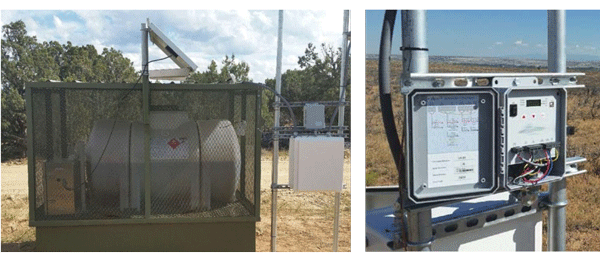
There is a need at many remote oil and gas field sites for data typically collected by specialized sensors (tank level, pressure, flow, and gas detection sensors; strain gauges; corrosion probes; etc.) along with cathodic protection (CP) data. Historically, if sensor data were collected, it was done independently of CP monitoring and reported back to the oilfield operators via a communications link such as a supervisory control and data acquisition (SCADA) system, says NACE International member Jamey Hilleary, director of business development with Elecsys Corp. (Olathe, Kansas).
“It was expressed to us by quite a few field personnel that they were increasingly in need of additional data at remote sites where they were currently acquiring cathodic protection data,” Hilleary says. This includes pressure information at valve sites where corrosion potentials of oil and gas pipelines are monitored; corrosion inhibitor levels in holding tanks on injection skids at production sites where CP values for well casings and gathering pipelines are being acquired; corrosion rates at cased crossings where casing and carrier pipe-to-soil (P/S) potentials are tracked; and test point sites where data on corrosion rates in the soil are desired, he notes.
To meet this need, Elecsys developed the SentraLink CP†, a remote CP monitoring platform that combines a dedicated two-channel CP rectifier/test station monitoring device and a dedicated two-channel sensor/transducer monitoring device into one unit. “Wherever CP monitoring is done, this technology adds the ability to monitor sensors and transducers at the same location,” Hilleary comments. Combining CP and operational data into a single device provides additional site data that present a more complete picture of the corrosion environment being controlled.
The device incorporates two analog voltage input channels that can measure two CP-related values—rectifier voltage, rectifier current, and structure-to-soil potentials—and two sensor/transducer input channels for measuring two separate sensor readings such as temperature, pipe pressure, fluid level in a tank, corrosion rates (internal or external using electrical resistance [ER] or linear polarization resistance [LPR] probes), etc. Each of the sensor/transducer channels can be used with 4- to 20-mA, 0.0- to 5.0-V, or 0.0- to 10.0-V transducers with two- or three-wire configurations, and the unit is capable of sending a 24-V excitation signal to activate the transducers so measurement readings can be taken. The system is powered by the same power source used for the rectifier.
As an example, Hilleary cites an installation at a production well site, explaining that the two voltage channels on the remote monitoring unit are used to measure the well casing CP values and the P/S potentials on the underground piping that connects all the storage wells in the gathering system. A corrosion inhibitor injection skid is installed at the production site, and one sensor/transducer input channel in the remote monitoring unit is used to measure the level of corrosion inhibitor in the holding tank, while the other sensor/ transducer input channel is connected to a corrosion probe inside the well casing.

The remote monitoring unit operates on a report-by-exception protocol, and intermittently polls the devices for data by sending an excitation signal to the transducers, which activates the sensors. The frequency of the interrogations depends on the type of data being collected and can range from once every minute to once an hour or longer. The sensors take a reading, and the transducers convert the sensor reading into a corresponding amount of voltage and send it back to the monitoring unit. Basically, Hilleary explains, the amount of voltage returned determines the measurement value based on the voltage range of the transducer. For instance, if the returned voltage from the fluid level sensor for the corrosion inhibitor holding tank is 2.5 V and the transducer range is 0.0 to 5.0 V, where 0.0 is empty and 5.0 is full, then the inhibitor level in the holding tank is ~50%.
A desired measurement range for all sensors is determined, with low and high limits set. If the sensor measurement falls within the established range, then data are sent periodically via cellular or satellite communication to a Web-based user interface according to a predetermined schedule so they can be viewed, graphed, and combined as needed. If measurements are within the normal range, everything is fine and the user doesn’t need to be immediately updated, Hilleary comments, noting that normal readings are typically sent at least once a week to assure users that the remote CP monitoring unit is functional. If the measurements are not within the established range, then an alarm notification is sent without delay to users associated with that site via text and/or e-mail. If measurements return to normal when the devices are polled again, then a return-to-normal notification is also sent.
In the case of the corrosion inhibitor holding tank, if the measurement fell below the sensor’s low limit, it would trigger an alarm and the person responsible for filling the inhibitor tank would be notified, and a trip to the remote site would be necessary to keep the corrosion inhibitor flowing and ensure the production site is corrosion free. Previously, corrosion personnel would need to make random trips out to the site to verify the corrosion inhibitor system was operational, and often would either top-off a fairly full holding tank or fill up an empty one. For other measurements, data loggers on remote systems would be checked and data collected weekly or monthly. “If you’re data logging and retrieving data at the end of each month, you will see the data, but any alarm occurrence or anomaly in the system has already happened, and it wasn’t acted upon until it was discovered,” Hilleary says. “Neither of these methods—making random trips to the field or using data loggers and retrieving data after the fact or on a periodic basis— provide actionable data at the time of the occurrence.” By monitoring various data types with a single device, he adds, the additional site data provide the CP professional with more comprehensive corrosion information about the remote environment being controlled, which provides cost savings by reducing the number of trips to field sites.
The remote CP monitoring unit went into commercial production in September of 2014. Applications include well sites where casing rectifier voltage, rectifier current, and fluid levels for storage and waste tanks are monitored; gas storage wells where rectifier output, P/S potentials, and tank pressures are measured; test stations and cased crossings where potential measurements and corrosion rate measurements (derived from ER or LRP probes) are used in conjunction with one another for pipeline integrity management; and any other application where a combination of sensors, transducers, and CP values are monitored. The technology is currently in use at several cased crossings where the casing has been filled with a vapor-phase inhibitor and the device tracks the corrosion rate in the annular space as well as potentials from the casing and the carrier pipe. It is also being used in a gas storage field where pressure and P/S potential measurements are required from each well.
Contact Jamey Hilleary, Elecsys Corp.—e-mail: Jamey.hilleary@elecsyscorp.com.
†Trade name.